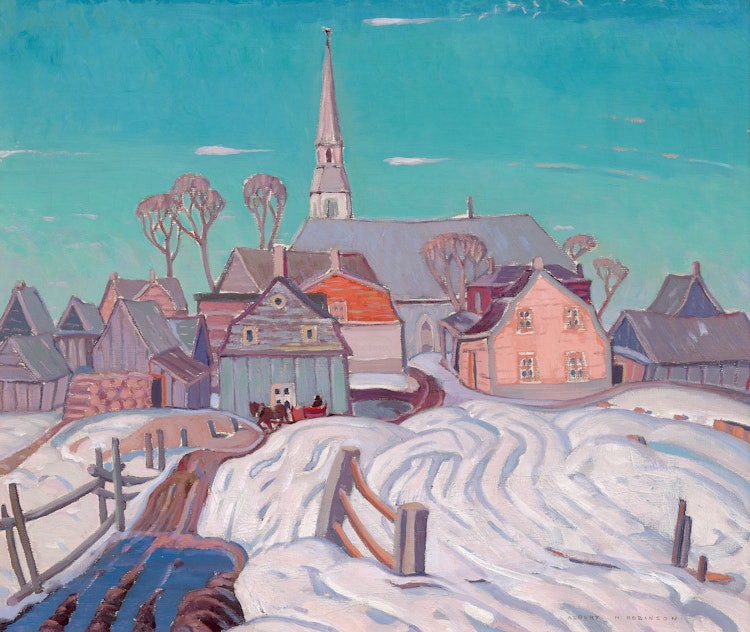Les Éboulements en haut by Albert Henry Robinson

Albert H. Robinson
Les Éboulements en haut
oil on canvas
signed lower right; titled and dated "circa 1924" on the gallery labels on the reverse
22 x 26 in ( 55.9 x 66 cm )
Auction Estimate: $100,000.00 - $120,000.00
Price Realized $168,000.00
Sale date: May 30th 2024
G.L. Robinson
G. Blair Laing, Toronto
A.K. Prakash & Associates, Toronto
Masters Gallery, Calgary
Private Collection
Possibly Royal Canadian Academy of Arts, n.d., as "Les Éboulements en haut"
A.Y. Jackson to Clarence Gagnon, 20 March 1927
Arthur Lismer, "Canadian Picture Study", Toronto, 1940, page 18
the 1920s and into the early 1930s, his annual trips in Beaupré and Charlevoix counties included visits to Saint-Tite-des-Caps, Baie-Saint- Paul, Les Éboulements, Murray Bay (now La Malbaie), Saint-Fidèle and Saint-Siméon.
Robinson and A.Y Jackson both painted oil sketches of Les Éboulements in the early 1920s, painted from a similar vantage point and with the church steeple positioned slightly left of centre. There are significant differences between the sketches, although these are not sufficient to obviate the possibility that they were painted at the same time‒and, indeed, the verso label indicates that Robinson at one point owned the Jackson. Robinson treats the buildings more individualistically, whereas Jackson abstracts them to emphasize their compositional rhythm: a decision that perhaps accounts for his omission of Robinson’s decorative trees and his simplification of the foreground fences.
"Les Éboulements en haut" embodies the qualities for which Arthur Lismer praised Robinson in one of his 1940 Canadian Picture Study booklets: “In Robinson’s pictures we expect no great dramatic subject treatment, nor dynamic lines and sombre tones. His art is the colorful expression of daily life, full of charm, devoid of sentimentality.” The qualities of intimacy and harmonious colour that Jackson associated with the north shore are certainly present in Robinson’s painting: “The south shore,” wrote Jackson, “... depends more on the contours of its big spaces ... its [sic] too intricate for sketching”. Indeed, part of the attraction of "Les Éboulements en haut"‒like that of many other 1920s works by Robinson‒resides in the deceptively simple compositional contrasts, in this case between the horizontality of the clustered buildings, and the soft diagonals of the foreground road, posts and snowdrifts. Equally characteristic of Robinson’s technique is the refined colour scheme, with the subdued purplish tonality of the buildings punctuated by carefully placed areas of warm pink, orange, yellow and white, under a beautifully painted two-toned sky. When comparing Robinson’s oil sketch with the finished canvas version of the same name, the two works appear quite similar. The only striking compositional difference between the sketch and the canvas is a rearrangement of the sketch’s foreground fences: an alteration presumably made to increase the speed with which the eye travels from foreground to middle ground.
We extend our thanks to Brian Foss, Carleton University Chancellor’s Professor of Art & Architectural History, and co‒curator of "1920s Modernism in Montreal: The Beaver Hall Group" for his assistance in researching this artwork and for contributing the preceding essay.
Share this item with your friends
Albert Henry Robinson
(1881 - 1956) Canadian Group of Painters, RCA
Albert Henry Robinson (RCA) was born in Hamilton, Ontario in 1881. Robinson studied in Hamilton with John S. Gordon and left for Paris in 1903. He continued his training at the Julian Academy with Bouguereau and Bachet, and then with Ferrier at the L’Ecole des Beaux-Arts. During his time there he travelled to Normandy and Corsica. After returning to Hamilton, John S. Gordon hired him as an assistant and Robinson exhibited his work for the first time in 1906. In 1910 he met and befriended A.Y. Jackson. Between 1918 and 1933 Robinson travelled along the shores of the St. Lawrence and in the Laurentians painting many landscapes, which constitute the bulk of his work.
Robinson was a member of the Pen and Pencil Club of Montreal and the Arts Club of Montreal. He was also elected a member of the Royal Canadian Academy of Arts in 1920, the same year in which he participated as a guest artist at the inaugural exhibition of the Group of Seven in Toronto. He also was a founding member of the Beaver Hall Group in 1920 and the Canadian Group of Painters in 1933.
Robinson's work is in the National Gallery of Canada, Ottawa; the Art Gallery of Ontario, Toronto; the Art Gallery of Hamilton; McMichael Canadian Art Collection, Kleinburg; Montreal Museum of Fine Arts; the Musée national des beaux-arts du Québec and the Musée National d'Art Moderne, Paris, among others.

